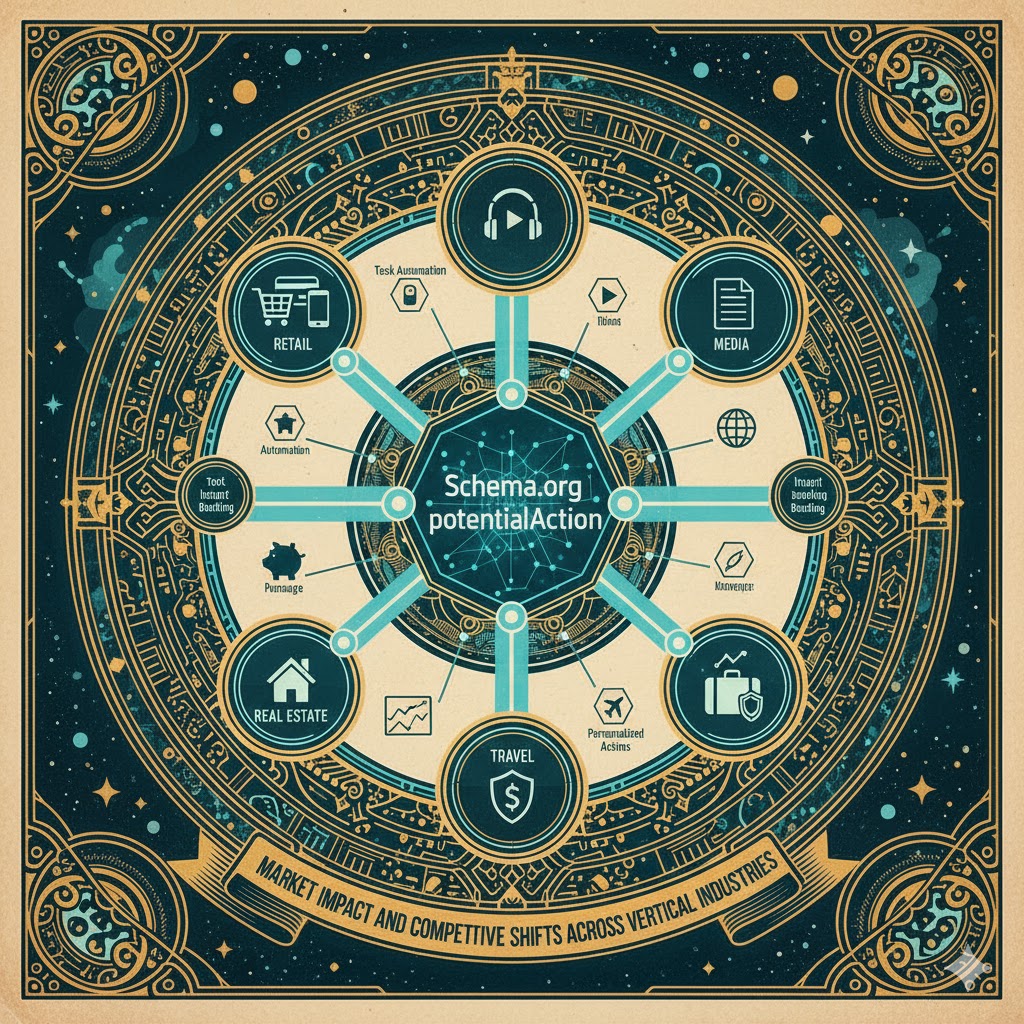Introduction
Artificial‑intelligence search and voice assistants are rapidly changing how users discover and interact with web content. Schema.org’s potentialAction property allows publishers to express the actionable intent of a resource (read, buy, reserve, contact, donate, etc.) using nested Action objects. When combined with EntryPoint/target details and optional input parameters, potentialAction enables deep links and call‑to‑action (CTA) buttons to appear directly in search results, AI assistants, and agentic browsers. This report explains the property’s core functionality, details adoption across major verticals, and evaluates the resulting market impact and competitive dynamics.
Overview of potentialAction
- Definition: Schema.org’s
potentialActiondescribes an Action that could be performed on a Thing—for example reading an article, searching a site, buying a product or reserving a hotel. TheActionis expressed as an object with a@type(e.g.,BuyAction), atargetlinking to anEntryPoint(often a URL template), and optional fields specifying input parameters. Schema examples from Schema.org showSearchActionfor site search,BuyActionfor e‑commerce, and note that the property can be used to define actions like posting a review or watching a videoschema.org. - Purpose:
potentialActionconveys the user’s next step to search engines and assistants. When present, Google and other AI platforms can surface actionable links or buttons (e.g., “Buy”, “Reserve”, “Read”). This facilitates frictionless transactions and increases the visibility of CTAs within AI‑powered interfaces.
Why potentialAction matters
- Enhanced rich results and voice search: Structured data with
potentialActionhelps search engines understand how users can interact with a page. Evidence suggests that structured data increases click‑through rates and makes content eligible for featured snippets and voice assistant resultsuptickmarketing.com. A case study from a cooking site reports 41 % higher engagement after adding related recipe prompts viapotentialActionin voice answersempathyfirstmedia.com. - Deep linking and user journeys: With
EntryPointandurlTemplate,potentialActioncan drive users directly into transaction flows such as site search, product checkout or booking. This reduces friction and allows AI assistants to complete tasks on the user’s behalf. - Support for emerging agentic browsers and AI Overviews: Assistant‑optimized markup helps websites remain discoverable in environments where conversational AI summarises and navigates the web.
Vertical‑specific implementations and benefits
1. E‑commerce and retail
BuyActiontriggers buy buttons: In product structured data, adding aBuyActionwith aurlTemplatefor the checkout page can surface a buy button directly in Google results. A developer article notes that Google’s “Buyable” rich result is triggered byBuyActionand can show a “Buy” button next to the product namedev.to. This reduces the number of clicks from discovery to purchase.- Competition and differentiation: Retailers that implement
BuyActioncan dominate AI shopping interfaces. Competitors without such markup risk being buried in generic product summaries. As more marketplaces and brands adopt the action, smaller businesses may struggle to stand out unless they also provide explicit purchase actions.
2. Local services and small businesses
SearchActionfor site search boxes: Local business guides recommend adding aSearchActionto theWebSiteschema to let Google display a site‑search box in search resultschazedward.com. Another article provides a JSON‑LD example where thetargetis the internal search URL andquery‑inputindicates the search parametermoldstud.com. This helps prospective customers find specific services or products quickly.ContactActionand booking actions: AI SEO guides advise usingContactActionto define how to contact the business (call or form submission) and using appropriate booking actions (e.g.,ReserveAction,OrderAction) to link to reservation or booking pageswebstix.com. Providing these actions helps assistants present “Call now” or “Book appointment” buttons, which is essential for service businesses (e.g., plumbers, salons) and reduces the impact of third‑party booking platforms.- Competition: Businesses that adopt
potentialActioncan capture a larger share of voice‑assistant bookings. For example, a restaurant that defines bothReserveActionandOrderActioncan appear in AI recommendations for both table reservations and online orders, while competitors without markup may remain in generic listingsonthemap.agency.
3. Hospitality, travel and leisure
ReserveActionfor hotels and restaurants: Sample markup for hotels shows apotentialActionof typeReserveActionwith anEntryPointandLodgingReservationresult for booking a roomonlineownership.com. Hospitality guides encourage restaurants to includeReserveActionfor table bookings andOrderActionfor food ordersonthemap.agency. Golf courses can useReserveActionto book tee times, specifying theactionPlatform(desktop, mobile) andactionApplication(e.g., Google voice assistant)sagacitygolf.com.OrderActionfor service ordering: In ski resorts or tourism,OrderActioncan offer packages or passes directly. A restaurant example includes bothReserveActionandOrderActionin thepotentialActionarray, enabling multiple CTAs (reserve table or order take‑out)onthemap.agency.- Competitive implications: Early adopters secure prime placement in voice search results and knowledge panels. Hotels with
ReserveActionmay appear in AI overviews with direct booking links, potentially bypassing online travel agencies (OTAs). Smaller establishments lacking structured actions might be excluded from one‑tap booking experiences.
4. Healthcare and wellness
ReadActionto define primary interaction: In health content, aReadActionwithin the schema clarifies that the user’s main task is to read an article. Sitebulb’s healthcare schema guide notes that this helps search engines understand the intended user engagement and may contribute to AI summarisationsitebulb.com.- Scheduling appointments: While not directly cited, emerging
ScheduleActionpatterns (e.g., for clinics or telehealth) can connect to appointment‑booking systems. This would allow voice assistants to book doctor visits directly. - Market impact: Accurate
potentialActionmarkup builds trust with AI health assistants by specifying whether the page is for reading or booking. As voice‑driven health queries grow, clinics offering appointment booking actions may attract more patients.
5. Media, entertainment and streaming
WatchActionandListenAction: Media actions enable immediate playback of videos, movies, podcasts or radio. Google’s media actions feed usesWatchActionorListenActionto deep link to streaming servicestekkidigital.com. Video SEO guides emphasise usingWatchActioninVideoObjectto represent view counts and user interactionshikeseo.co, whileSeekToActionallows users to jump to specific timestamps within a videodevelopers.google.com. A radio station implementingListenActionandSearchActionensures that voice assistants can play its stream and search showsfortdodgeradio.com.- Competition and distribution: Streaming platforms with structured
WatchActiondeep links can secure priority placements in AI results, potentially reducing reliance on aggregator apps. Traditional broadcasters and smaller podcasts that do not adopt this markup may be overlooked by voice‑assistant listeners.
6. Education and interactive services
SolveMathActionand interactive actions: Google’s math solver structured data usesSolveMathActionin thepotentialActionproperty with atargetURL and amathExpression-inputparameterdevelopers.google.com. This enables voice assistants and search to route math problems directly to solvers. Other educational tools could useAskAction,CheckActionorAssessActionto enable similar interactivity.- Impact: Educational platforms that mark up interactive tools will gain prominence in voice search results for questions like “solve 2x+3=7” or “check grammar.” This could shift user traffic from general search results to specific interactive services.
7. Books and digital publishing
ReadActionandBorrowAction: Google’s book schema examples show howReadActionlinks to a store page for purchasing or reading and includes offers with price and region informationdevelopers.google.com.BorrowActioncan describe how to borrow a book from a library. Including these actions allows search and assistant interfaces to present “Read sample” or “Borrow” buttons.- Market shift: Publishers that implement these actions may capture sales directly through AI search results, bypassing third‑party retailers. Libraries can highlight their lending options, potentially increasing usage.
8. Nonprofits and charities
DonateAction: A nonprofit AEO guide encourages usingDonateActionin thepotentialActionfield to mark up donation pages, enabling voice assistants to prompt donationsranktracker.com. The markup can specify minimum donation amount, currency and target link.- Competitive edge: Nonprofits that adopt this action may secure the first “Donate” suggestions in AI results. As philanthropic giving becomes more voice‑driven, organisations lacking donation actions could lose potential donors.
9. Other sectors
- Sports and leisure: Golf courses can use
ReserveActionfor tee timessagacitygolf.com. Gyms or sports clubs might adoptJoinActionorBuyActionfor memberships and class bookings. - Restaurants with multi‑action: Food establishments can present
ReserveActionandOrderActionconcurrently, giving users options to book a table or order deliveryonthemap.agency. - Subscription services: Media or software companies can use
SubscribeActionto indicate subscription sign‑up pages. - Financial:
PayActionorInvestActioncould allow micro‑transactions or stock purchases, though caution is needed because of financial regulations. Adoption is limited due to compliance requirements.
Market impact and competitive changes
1. Increased competition for AI prominence
potentialAction transforms search results from passive listings into transactional experiences. This fosters a winner‑takes‑most dynamic: pages offering one‑tap actions are more likely to be promoted by AI assistants, pushing down those without markup. Competition will intensify within each vertical as businesses fight for the limited space of AI‑driven rich results.
2. Platform disintermediation
Direct actions can reduce dependency on third‑party platforms. For instance, hotels that implement ReserveAction may encourage direct bookings, reducing commissions paid to OTAs. Restaurants with OrderAction may avoid delivery app fees. However, this also threatens aggregator revenue streams, possibly leading to new partnerships or exclusive deals (e.g., Google requiring partnerships for media actionstekkidigital.com).
3. Voice and agentic commerce
As voice search usage grows—forecast to be over half of queries by 2026empathyfirstmedia.com—businesses not optimized for conversational interactions risk losing relevance. potentialAction ensures that AI can understand and execute a user’s intent, placing adopting businesses ahead. This shift toward voice‑driven commerce favours verticals that can provide frictionless actions (e.g., quick food ordering or reordering supplies).
4. Data standardisation and trust
Structured actions provide a transparent and standardised method for assistants to understand transaction flows. This can increase trust and reduce ambiguity, particularly in regulated industries like healthcare and finance. The ability to specify required input fields and deep links ensures that AI does not misinterpret the user’s intent.
5. Challenges and barriers
- Implementation complexity: Many businesses are unaware of Schema.org or lack technical capacity. Crafting correct JSON‑LD and maintaining it can be challenging. Tools and CMS plugins help but adoption is still nascent.
- Regulatory and platform constraints: For actions involving money (e.g.,
DonateAction,OrderAction) or personal data (health/finance), compliance with privacy laws and platform policies is critical. - Platform approval: Some actions, such as Google’s media actions, require partnership or approval, which may favour larger playerstekkidigital.com.
Conclusion
Schema.org’s potentialAction property is a powerful mechanism for making web content actionable in AI search results, voice assistants and agentic browsers. Across verticals—e‑commerce, local business, hospitality, health, media, education, publishing and nonprofit—potentialAction facilitates direct user engagement through buy buttons, reservation links, donation prompts and more. Early adopters gain a competitive edge, enjoying increased visibility and conversions while bypassing intermediaries. As AI‑driven interfaces become mainstream, not adopting potentialAction may leave businesses invisible to users who rely on conversational search. However, proper implementation, regulatory compliance and continuous optimisation are essential to fully realise its benefits.









